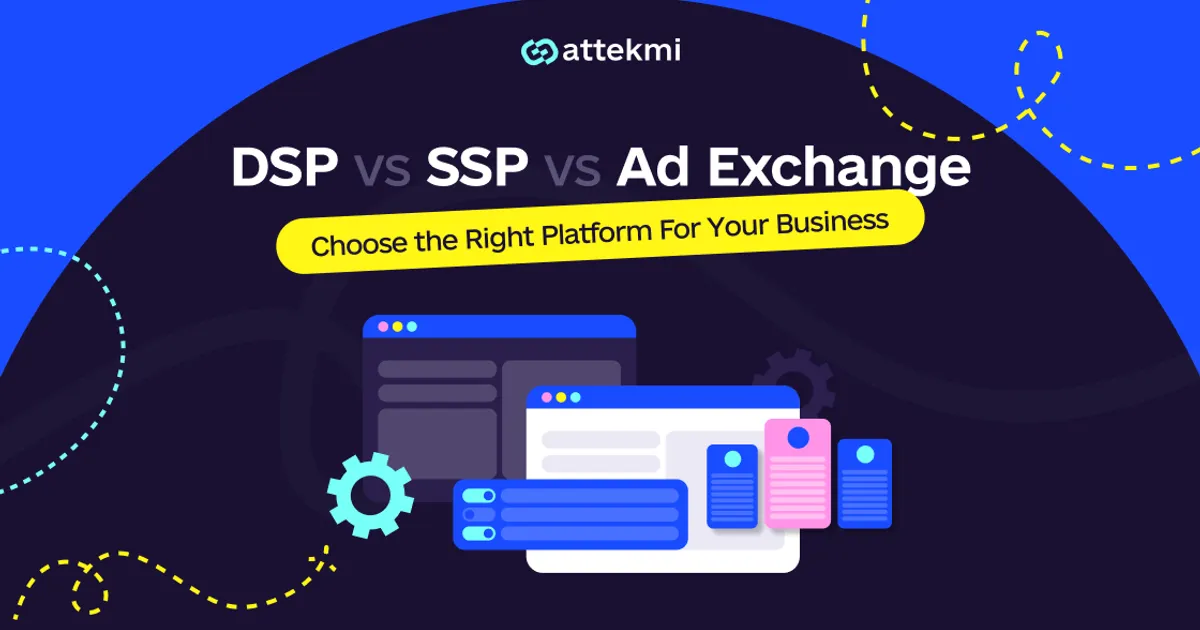Programmatic technology keeps conquering the digital advertising industry, and the reason for this is pretty straightforward. Thanks to automation capabilities, programmatic streamlines the process of buying and selling ad inventory, allowing both marketers and publishers to reach their goals effectively while still being able to focus on their core tasks.
The operation of programmatic advertising is enabled by three main components: demand-side platforms (DSPs), supply-side platforms (SSPs), and ad exchanges. But what is the difference between DSP and SSP? What role does an ad exchange perform? How to choose the right platform for your business? This guide is here to answer these and other questions, so keep reading to learn more.
Much like choosing the right programmatic platform, businesses often face decisions between private vs white label solutions for their advertising needs. Understanding the differences can help you select the platform that best suits your strategy — whether you're seeking a fully customized solution or a more streamlined, rebranded option.
Key Takeaways
DSPs, SSPs, and ad exchanges form the core of the programmatic advertising ecosystem:
DSP (demand-side platform): used by advertisers to buy ad inventory and run targeted campaigns;
SSP (supply-side platform): used by publishers to sell inventory and optimize revenue;
Ad exchange: connects DSPs and SSPs, facilitating real-time auctions for ad impressions.
While DSPs focus on buying and SSPs on selling, ad exchanges enable automated matching, pricing, and delivery between both sides in real time.
Choosing the right platform depends on your role in the ecosystem. Marketers use DSPs, publishers use SSPs, and media trading businesses rely on ad exchanges.
Critical features to evaluate include user interface, fraud protection, brand safety controls, platform updates, and available programmatic models (e.g., RTB, header bidding, PMP).
Attekmi offers ad exchange solutions with support for all major ad formats (banner, video, native, CTV, audio) and environments (in-app, desktop, mobile web).
What is DSP?
A DSP is a programmatic solution for advertisers. They use such platforms to launch marketing campaigns across diverse environments (including CTV and digital out-of-home devices), and advanced targeting capabilities allow them to reach exactly those users who are most likely to convert. The process of ad buying is automated, it is only essential to set everything up. In this way, marketers can purchase ad space from many publishers at scale – real-time bidding (RTB) auctions are completed within less than a second. Additionally, many DSPs are equipped with various optimization features, which helps ensure efficiency and cost-effectiveness.
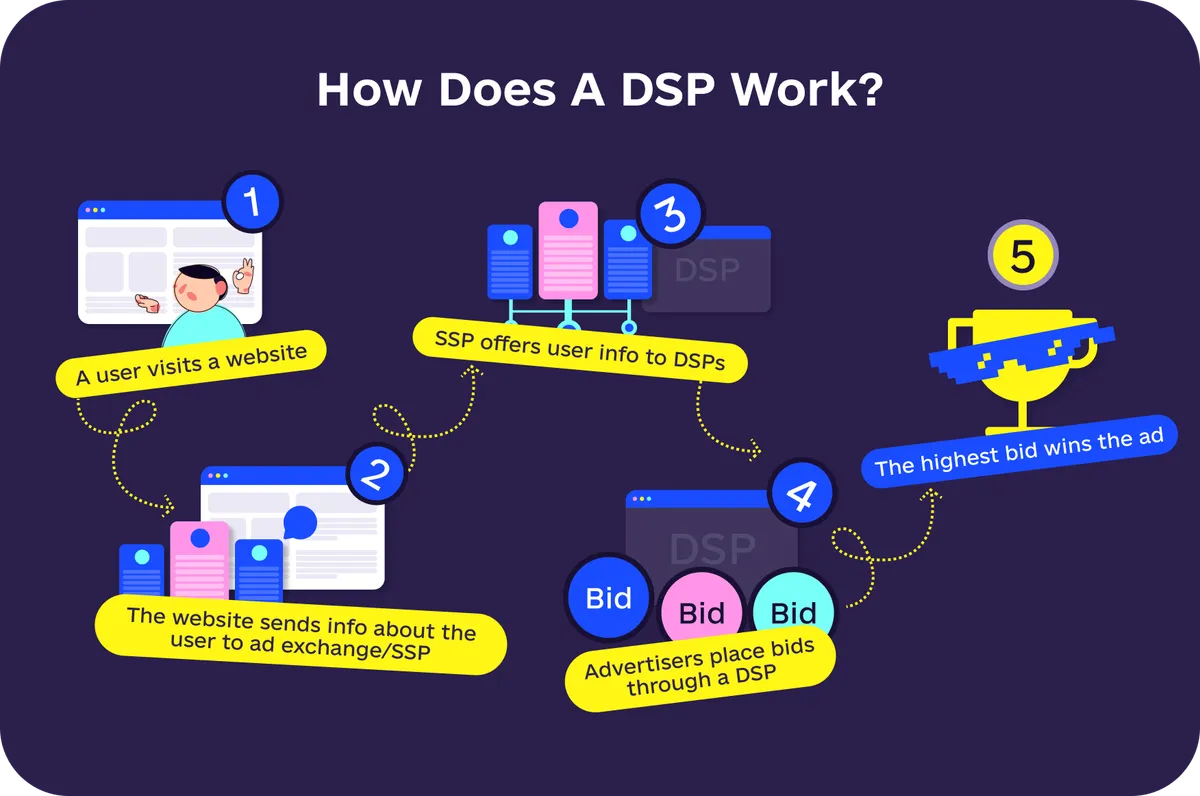
Source: Medium
What is SSP?
In turn, an SSP is the opposite of a DSP – it is a programmatic platform for publishers. Media owners leverage such solutions to sell their ad inventory to relevant advertisers – this allows them to monetize their ad space and deliver relevant experiences to their visitors and users. Using an SSP is a much more effective monetization option than searching for appropriate advertisers manually. The inventory is offered to a large pool of marketers, which positively affects the publisher’s income. Besides, by applying SSP’s filtering settings, media owners can ensure greater relevance of advertisements and deliver ultimate experiences to their users.
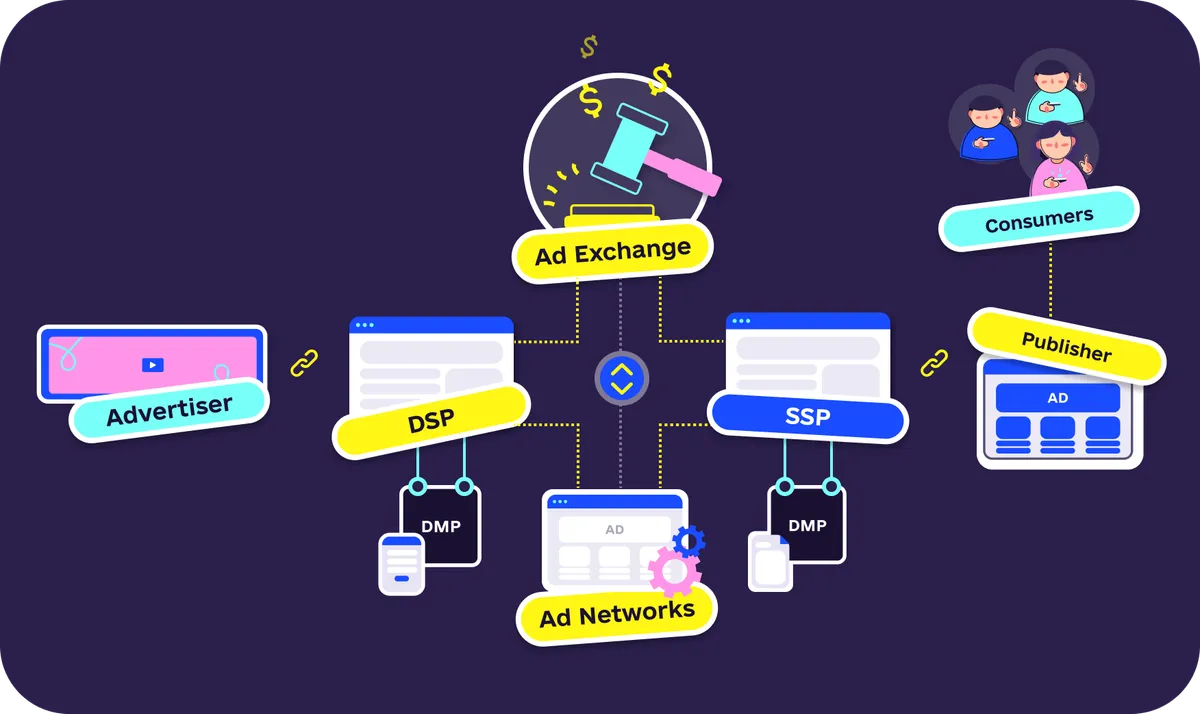
Source: Medium
What is an ad exchange?
An ad exchange performs as an intermediary between DSPs and SSPs. It is a programmatic marketplace where real-time and header bidding auctions happen. An exchange gathers the available inventory, offers it to demand-side platforms, and allows advertisers to bid on impressions. Understanding how does ad serving work is essential here, as the ad exchange informs an ad server when the winning bid is identified, ensuring the ad is delivered to the right user at the right time.
While programmatic advertising still has some models that require negotiations between marketers and publishers (like direct deals), ad exchange is the platform that ensures automation.
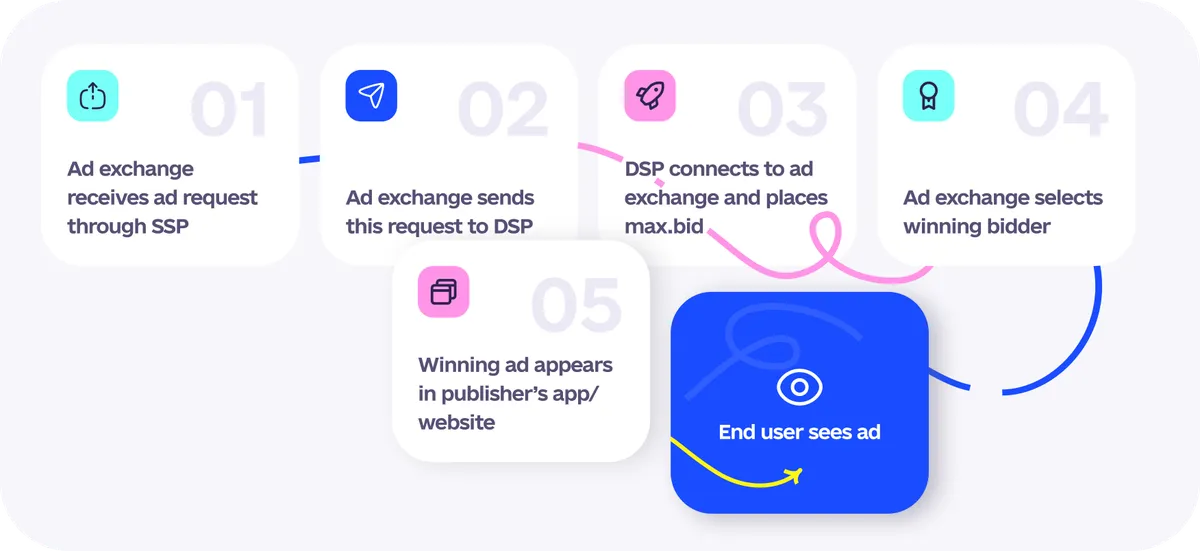
DSP vs SSP vs ad exchange: which platform is right for your business?
Before we start comparing SSP vs DSP vs ad exchange, let us provide you with a bit more information about the programmatic ecosystem. The platforms we described above are the key participants, but they are not the only ones. Here are three more definitions that you should be aware of:
DMP (data management platform). A platform that gathers, arranges, and analyzes data from a variety of sources – the data is then used to ensure precise targeting and personalization. The data can be collected, for instance, from ad servers, visited websites, advertising systems, and so on.
Ad network. Being often confused with an ad exchange, an ad network also acts as an intermediary between publishers and advertisers. The main difference is that an ad exchange is an open programmatic marketplace, while an ad network vs ad exchange sells ad inventory on behalf of publishers. Ad networks often focus on premium inventory, however, they have certain disadvantages. For publishers, this is a lack of control. For advertisers – a lack of transparency. In general, the fewer intermediaries are involved in the media buying and selling process, the better.
Ad server. Ad servers store and deliver advertising content to the publisher’s website or app. Additionally, servers gather statistical and campaign performance data after analyzing the users’ interactions with programmatic ads.
Now that you are familiar with the definitions of an ad exchange, ad network, data management platform, ad server, SSP and DSP, it is time to move further. Let’s explore the difference between SSP and DSP in greater detail, learn more about ad exchanges, and discover what platform is the best choice for your business to succeed.
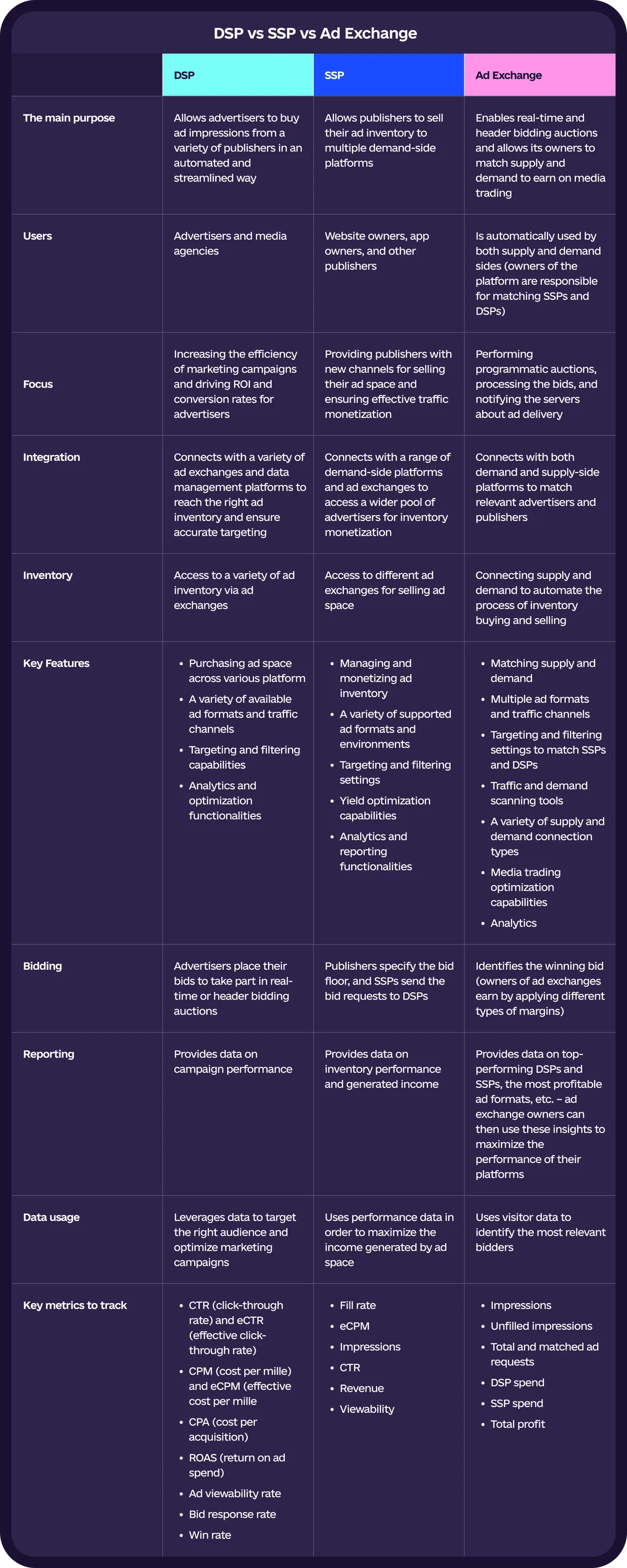
As for the metrics to monitor, it is important to remember that the selection highly depends on your goals. Paying attention to all the data provided by your programmatic platform will help analyze the whole picture but prioritizing the metrics that reflect your objectives is a way to discover if you are achieving them.
Besides, whether it is SSP vs DSP, ad exchange vs DSP, or ad exchange vs SSP, it is essential to understand not only the differences between these platforms when choosing one. There are a lot of demand-side platforms, supply-side platforms, and ad exchanges available in the market, so, after you decide which type of solution you need, pay attention to the following factors:
User interface. An efficient programmatic platform should have a variety of features, and learning how to use them, as well as the basic functionalities, may take some time. However, the interface itself should still be intuitive.
The available selection of programmatic models. Programmatic advertising comes in different forms: real-time bidding (RTB), header bidding, guaranteed deals, private marketplaces, and so on. RTB and header bidding are the most popular options, but having access to additional ones is still a benefit. This provides you with greater freedom of choice, whether you are an advertiser, a publisher, or an owner of the ad exchange platform.
Ad fraud prevention capabilities. Ad fraud is a challenge for all the parties involved in the programmatic industry. Therefore, you should search for a platform that offers fraud detection and prevention capabilities. For advertisers, this is a way to solve the problem of fake clicks and other fraudulent activities. For publishers, such tools mean an opportunity to prevent malicious creatives from reaching their media sources. As for ad exchange owners, they need such scanners to ensure a safe ecosystem for their demand and supply partners.
Brand safety functionalities. For those searching for a demand or supply-side solution, it is also crucial to pay additional attention to filtering capabilities. If you are an advertiser, you do not want your ads to appear in an inappropriate context. If you are a publisher, you would like only high-quality advertisements to be displayed on your website or in your application. In any case, you need your platform to support the creation of white and blacklists. The availability of contextual targeting functionality will be useful too.
Customer support. One more important thing to consider is the quality of support service. Obviously, it is complex to evaluate it when choosing the platform, but you can start by contacting the providers and checking how promptly they respond and how helpful they are. Discovering if there is an extensive knowledge base would be helpful as well.
Platform updates. The programmatic industry evolves continuously, so, to remain competitive and effective, the right platform should be regularly updated with new features. In case a solution was last updated a couple of years ago, you are not likely to reach top performance with it.
Finally, it is always useful to look for reviews on the Internet. Using platforms like G2 and Clutch, you can learn more about the weaknesses and benefits of your potential programmatic solution. Checking out the case studies, if available, can provide you with additional insights.
Earn at your own ad exchange platform
Publishers use SSPs to monetize their ad inventory. Advertisers use DSPs to purchase ad space in an accelerated and automated manner. In turn, owners of ad exchange platforms can drive media trading income by matching supply and demand in the right way.
Building a programmatic ad exchange solution from scratch can be a time-consuming and expensive process, but, fortunately, there is a way to overcome this challenge and enter the market in the shortest time possible. At Attekmi, we offer an entire range of ad exchange platforms:
AdEx Basic: an entry-level platform that has all the functionalities essential to start earning on media trading.
AdEx Plus: an advanced version of AdEx Basic.
White Label Ad Exchange: a fully customizable ad exchange platform, from UI personalization to custom on-request feature development.
Additionally, one more solution is on the way. Soon, we will release AdEx Enterprise – a platform for those looking for ultimate functionality and scalability.
Our ad exchange platforms support all the ad formats your partners may need: banner, native, video, audio, and CTV ads. As for the available environments, they are as follows: desktop, in-app, mobile web, and CTV.
Besides, our solutions are fully compliant with international standards and regulations like GDPR and enable you to integrate various traffic and demand scanners to fraud-proof your ecosystem. Advanced targeting and filtering capabilities will help you match supply and demand effectively, and you will not be limited only to RTB integrations. Do you need, for instance, a VAST to RTB connection type? We have got you covered.
Apart from ad exchange solutions, we offer a variety of services, including custom AdTech development, Ad Ops outstaffing, and AdTech and Ad Ops team training.
With an ad exchange from Attekmi, BidderMob achieved 319% ROI and 100k QPS platform upscaling, and you can reach the same heights. Explore our other case studies to find out what value we can bring to your business.
Conclusions
If you have to choose between DSP and SSP, everything is rather simple – the main factor to consider is whether you need a platform for ad buying or monetizing your ad inventory. Alternatively, you may want to get your own DSP or SSP and offer your solution to marketers and media owners to drive income. As always, everything depends on your needs and goals.
If you would like to earn money through media trading, your choice is an ad exchange platform. However, you may still want to get your own ad exchange even in case you are a publisher or a marketer. Having an ad exchange implies greater control over the programmatic processes, as you will be able to match your DSP or SSP with the most relevant partners. Instead of relying on technology, you will have a more significant impact on the ecosystem.
Therefore, when choosing between ad exchange, DSP, and SSP, you should start by outlining clear goals. Each of these platforms has specific functionalities and “responsibilities” (we described them in this guide), and understanding them will help you make the right choice and move your business to the next level.
Interested in our AdTech solutions and services? Contact us to find out how we can help you!
FAQ
DSP vs SSP vs ad exchange. What is the difference between these platforms?
A DSP is a programmatic platform used by marketers to buy ad inventory automatically. An SSP is a platform for publishers – they utilize it to sell their ad space. An ad exchange is a digital marketplace that connects DSPs and SSPs.
SSP vs ad exchange: what is better for driving income?
In case you own a website or an app, utilizing an SSP will help you monetize your ad inventory. If you would like to earn money through media trading by matching supply and demand, getting your own ad exchange platform is the way to go.
What is the difference between an ad network and an ad exchange?
An ad exchange is a marketplace responsible for performing real-time and header bidding auctions. In turn, an ad network acts as an intermediary and sells publishers’ inventory on their behalf.
 By Anastasiia Lushyna
By Anastasiia Lushyna